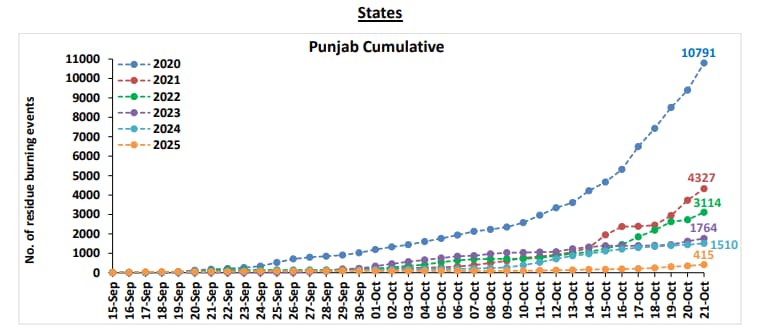ARTICLE AD BOX
Last Updated:October 22, 2025, 09:14 IST
Local sources dominated the pollution load, even as stubble burning incidents in Punjab fell sharply from 1,510 last year to 415 this year---a remarkable reduction of 72.5%

An anti-smog gun sprays water droplets to curb air pollution, with Rashtrapati Bhavan in the backdrop, as air quality deteriorates across northern India. (PTI)
Despite warmer weather and drastic fall in farm fire incidents in neighbouring states this Diwali, the national capital was enveloped in toxic haze a day after the festival. Pollution levels worsened as the Air Quality Index (AQI) plunged to ‘very poor’ levels (300-400) and settled there after a late-night peak, with local emissions offsetting the gains from fewer farm fires this season.
‘Very poor’ AQI levels indicate that people can experience respiratory illness due to prolonged exposure, the impacts of which worsen if its hits the ‘400 mark’ and enters the ‘severe category’.
DRASTIC FALL IN FARM FIRES
The daily mean contribution of stubble burning to Delhi’s PM2.5 concentrations remained minimal—0.8-1 per cent on October 20-21, according to the data maintained by the Indian Institute of Tropical Meteorology (IITM), Pune. The satellites detected roughly 45 farm fire counts over Punjab on October 20, falling from 67 the day before, with border districts of Amritsar and Tarn Taran contributing to majority of the incidents. Punjab has recorded fewer farm fires this season with just 8-10 daily incidents from September 15 to October 12, with an uptick during October 19-20-21 with a daily average of 58 incidents during the three days.

The total number of stubble incidents from six states—Punjab, Haryana, Delhi, Uttar Pradesh, Madhya Pradesh and Rajasthan—is on a decline since 2021, but it recorded a drastic fall in Punjab this year. In the aftermath of the floods and delayed harvesting, the fire counts fell from 1,510 during this period last year to just 415 this harvesting season so far (from September 15 till date). According to the satellite data maintained by the Indian Agricultural Research Institute (IARI), the number of stubble-burning incidents in Punjab fell sharply from 10,791 in 2020 to 4,327 in 2021, 3,114 in 2022, 1,764 in 2023, 1,510 in 2025 and just 415 this year. Sangrur district in Malwa region of Punjab, a hotspot for stubble fires, recorded just 14 farm fire counts this year.
Incidentally, of the total 1,729 farm fire counts recorded this harvesting season over six states, Uttar Pradesh contributed the maximum—660—followed by Punjab (415), and Madhya Pradesh (342).
FIRECRACKER BAN FLOUTED, LOCAL EMISSIONS DOMINATE
On the other hand, the bursting of firecrackers continued all through the night in the national capital, and till October 21 despite the restrictions imposed by the Supreme Court. The Apex Court had relaxed the blanket ban on firecrackers, allowing residents to burn only green firecrackers from 8pm to 10pm and 6am to 7am on October 19 and October 20—the day before and the day of Diwali. However, it continued well into October 21 night as well.
“Delhi’s average PM 2.5 levels crossed 250 ug/m3 (‘Severe’) on the night of October 20 after 9 PM. The levels started dropping after sunrise and came below 250 ug/m3 around 10 AM on October 21. The wind speed over the city has been below 10 kmph since October 19 and is expected to be below this level for the next two to three days. Due to unfavorable meteorological conditions, according to the AQEWS, the AQI is expected to be above 300 (‘Very Poor’) over the next two to three days," said Mohammad Rafiuddin, Programme Lead, Council on Energy, Environment and Water (CEEW).
POLLUTION PEAKS DURING DIWALI, SHOWS DATA
An analysis done by Climate Trends showed that PM2.5 concentrations in Delhi have shown a consistent increase during Diwali period over the last five years, with late-night peaks (22:00- 1:00) corresponding to higher firecracker activity. The year 2025 showed the highest recorded mean (488 μg/m3) and maximum concentration (675.1 μg/m3 post-Diwali), indicating severe pollution build-up. The Commission for Air Quality and Management in Delhi-NCR (CAQM) has already announced Stage 2 of the Graded Response Action Plan (GRAP) as AQI worsened. According to the daily mean recorded by the Central Pollution Control Board (CPCB), Delhi’s AQI spiked during the night touching ‘severe’ levels, but settled on average at 345 (very poor) on October 20.
Despite a remarkable drop in the stubble fire incidents during October-December, the winter pollution in Delhi has remained elevated, peaking around Delhi every year. Recent analysis by several organisations have shown how local sources of pollution—vehicles, industries, open burning of waste, use of solid fuels, construction and dust sources dominate the PM10 and PM2.5 load over the national capital, with vehicular emissions accounting for the largest share.
“It’s disheartening that even after years of witnessing the harmful effects of burning firecrackers during Diwali, we continue to deny the reality and repeat the same mistake. As individuals, we often overlook how severely this pollution impacts health; especially that of children, pregnant women, the elderly, and those who are unwell," said Aarti Khosla, founder and director, Climate Trends.
Stage 2 of GRAP, in effect in Delhi, requires strict enforcement of the actions like curbing dust, restricting the plying of polluting vehicles, avoiding open burning of waste and biomass, and urges people to keep their Pollution Under Control (PUC) under check for vehicles.

Srishti Choudhary, Senior Assistant Editor at CNN-News18 specializes in science, environment, and climate change reporting. With over a decade of extensive field experience, she has brought incisive ground repo...Read More
Srishti Choudhary, Senior Assistant Editor at CNN-News18 specializes in science, environment, and climate change reporting. With over a decade of extensive field experience, she has brought incisive ground repo...
Read More
First Published:
October 22, 2025, 09:14 IST
News india Delhi Air Turns Toxic After Diwali As Firecrackers Offset Gains From Fall In Farm Fires
Disclaimer: Comments reflect users’ views, not News18’s. Please keep discussions respectful and constructive. Abusive, defamatory, or illegal comments will be removed. News18 may disable any comment at its discretion. By posting, you agree to our Terms of Use and Privacy Policy.
Read More

 9 hours ago
6
9 hours ago
6









 English (US) ·
English (US) ·